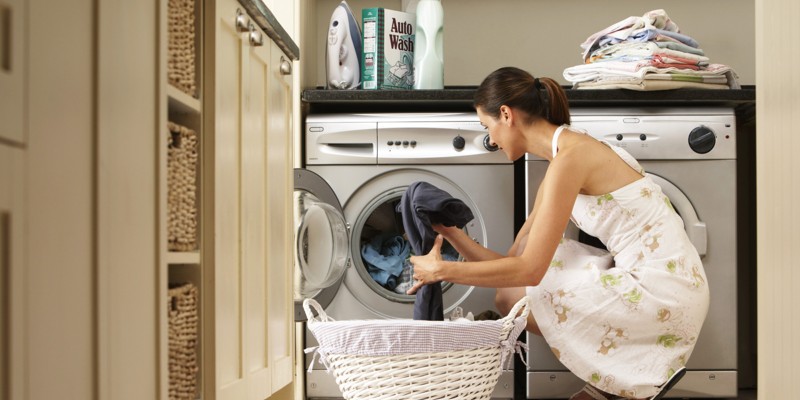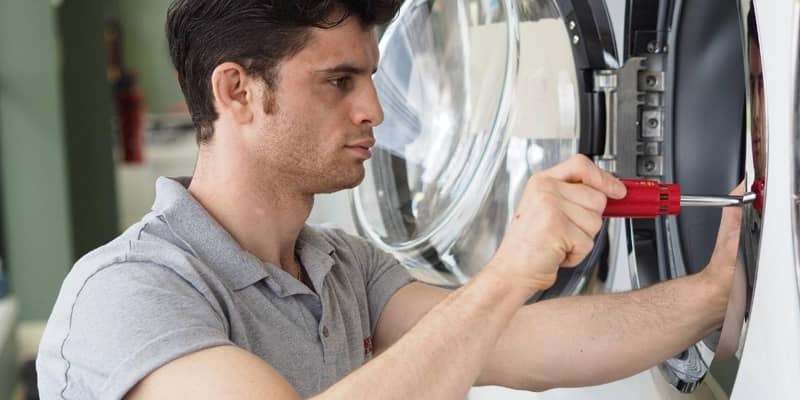If the washing machine LG does not drain the waste water, this most likely indicates a 'plug' somewhere in the exhaust path. There is a high probability that a sock or some other small item of clothing is stuck in the pump pump or in the coupling to it. Such a malfunction can be completely eliminated on your own.
The problem is less likely to be a broken pump. In this case, the washing machine LG also does not drain. However, it will not be possible to eliminate this malfunction on your own.
But, before contacting a service center, you should try to fix the problem yourself. Fortunately, washing machines LG are quite easy to disassemble, and all you need is a screwdriver and 'straight arms'.
What if the washing machine LG won't empty?

If the washing machine stops draining the waste water, you can try to remove the blockage yourself. This will require:
-
A tray for draining the soapy water remaining in the drum;
-
Lots of old towels so as not to flood the neighbors;
-
Crosshead screwdriver;
-
Instructions showing where the outlet filter is located;
-
Pliers or an adjustable wrench to tighten the clamp;
-
Plumbing cable;
-
Sobriety, confidence and firm hands.
The last is the most important. It is not difficult to disassemble and assemble the washing machine LG so that it retains functionality after all these 'operations'. But the wrong actions can lead to the fact that the damage will be more extensive – and you will have to buy expensive parts.
We will check in the following order:
-
Drain hose;
-
Exhaust filter;
-
Drain coupling;
-
Pump pump;
-
Drain hose.
A little theory before practice
To understand exactly where the necessary elements are located, it is worth understanding how exactly the washing machine LG drains the water. It happens as follows:
-
There is no outlet valve in the washing machine. Instead, the drain hose is located above the level of the tank and, according to the law of communicating vessels, it also fills when filled – but not completely;
-
The tank is connected to the sewage system through a system of four components – a drain coupling, a pump pump, a drain filter and a drain hose;
-
The drained water first enters the coupling, from there it is pumped through the filter into the drain hose, from there it is sent to the sewer.
-
The pump is designed to pump the water level. When it turns on, it simply pumps the liquid from the tank into the drain.
As a result, if there is a traffic jam in one of these places, then the entire path is blocked. And the washing machine LG won't drain the water.
Repair of a washing machine LG at home

So, let's try to remove the blockage ourselves. The most difficult thing in this process is to lift the washing machine and place it on the pallet in such a way that when draining the leakage sensor and the electric motor do not get wet. If possible, the ideal solution is to install it in a garage or on two stable stools.
Of course, before all operations, the washing machine must be de-energized, disconnected from the water supply and, if possible, the sewage system. Before turning off the water supply, turn off the water in the apartment or on the hose leading to the 'washing machine'.
We clean the drain filter
The outlet (drain) filter is designed to retain small debris that should not enter the drain. If towels or other fibrous items have been washed in the 'machine', it may be clogged with lint and water resistant.
The drain filter in washing machines LG is located in the lower left corner. It is accessed through a small hatch at the front.
Instructions:
-
Lift the washing machine or place a lot of towels under it to absorb the water;
-
Remove the plastic cover of the hatch;
-
Unscrew the drain filter. Be prepared for water gushing out of it;
-
Rinse the outlet filter under running water;
-
Clean the filter bed with a brush, cotton swab or banal finger.
If, after removing the filter (stage 3), water really gushed out of the device, the blockage was exactly in this place. However, if the liquid was previously scooped out or drained in some other way, only a few drops will appear from the resulting hole.
It is worth visually assessing the degree of filter contamination. If there really are a lot of lint or similar 'debris' on it, then the problem could be in it. It is worth filling the washing machine with water – at least partially – and trying to drain.
Did not work out? Let's move on.
We clean the drain coupling
A drain sleeve connects the tank to the pump. And it is in it that items of clothing such as socks, underwear, and other 'little things' are most often stuck. This 'plug', in turn, prevents the water from draining off.
The drain collar looks like a thick rubber hose that comes out of the funnel at the bottom of the tank. In this case, it is most advisable to remove it from the side with which it is attached to the pump pump – this is faster and will allow you to detect blockage at one of the following 'levels'.
Instructions:
-
Be sure to lift the washing machine LG and place it over the pallet. When removing the drain coupling, in any case, a lot of water flows out, which should not get into either the wet sensor or the electric motor, in order to avoid more serious damage;
-
Remove the back panel of the washing machine. It is usually held together by several bolts. Be careful – often both the back panel itself and the enclosure surrounding it are made of thin sheet metal with sharp edges;
-
Find the clutch. Unfasten the clamp that connects it to the pump pump. The clamp can be wire – then you have to make an effort to disconnect it – or in the form of an aluminum tape with fastening in the form of a bolt, which must be turned around;
-
Disconnect the coupling from the pump and immediately direct the socket downward, as water will flow from it;
-
Using a plumbing gauge, check that there are no plugs in the coupling up to the drum. If they are, try to remove them with your fingers. If it does not work, remove the coupling and push them out with a plumbing probe. Attention! Do not push dirt into the tank.
If the ill-fated sock or a similar item of clothing ended up in the clutch, reinstall it and check the operation of the washing machine.
When installing the coupling, it is very important to securely fix and seal it with a clamp. Otherwise, it will leak, which will negatively affect both the quality of the flooring and relations with the neighbors below.
Cleaning the pump pump
If no blockages are found in the coupling, and the washing machine LG still does not drain, then it is worth checking the cleanliness of the pump pump. Structurally, this device consists of a special discharge chamber, in which there is an impeller controlled by an external electric motor.
Your task is to open the camera. It is held in place by a few bolts that are easy to unfold.
Let's assume that your washing machine is already on the pallet and the sleeve has been removed from it.
Instructions:
-
Unfold the fastening bolts that secure the discharge chamber cover;
-
With the pump pointing down, remove the cover. Water should not flood the moisture sensor, the windings of the electric motor and the drive of the pump itself;
-
Remove dirt from the pump.
All. Now check the impeller. It should turn easily and not block. If you cannot turn it, most likely the pump is simply broken and will need to be replaced.
Also at this stage, you can check the dirt in the drain hose. To do this, insert a plumbing probe (cable) into it from the outside, having previously unscrewed the outlet filter. The cable should go all the way through the hose, coming out somewhere in the pump area.
What if cleaning doesn't work?
If all parts of the drain path are cleaned – both the coupling, the pump, and the hose – and the washing machine LG still does not drain the water, then contact a service center. The reasons for this 'behavior' can be different.
The first option is the drain pump burned out. This is rare, but it happens. For example, bra's 'bones' get stuck in it, after which the impeller is blocked and when you try to turn it, the drive simply burns out. In this case, the pump must be changed.
The second option is that the current-carrying circuits to the pump are broken. You will need to restore contacts, lay new wires, and so on. This is also a task for a service center specialist.
And the third option – the control board itself is damaged. The problem is very serious, the module will have to be ringed, inspected, flashed, and so on, and in critical cases, even changed. And it is also best done in a service center.









